Tibidabo is a mountain just northwest of Barcelona, crowned with the Church of the Sacred Heart. But the mountain’s main draw is the Parc d’Attractions, a more than one hundred-year-old funfair.
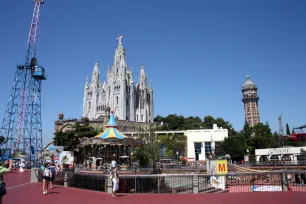
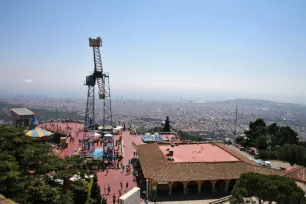
With a height of 512 meters (1680 ft), the Tibidabo marks the highest summit of the Collserola mountain range that borders the city to the north. The name (meaning I shall give you) stems from a fragment of the Latin version of the bible, in which Satan supposedly takes Christ to the top of a mountain and offers him the world with the words ‘Haec omnia tibi dabo si cadens adoraberis me’ (All this I shall give you if you kneel and worship me).
From the top of the mountain, you have an amazing panorama over Barcelona and the Mediterranean Sea. These views alone are worth the trip to Tibidabo, but there’s much more to see here, including a communications tower with an observation deck, a bombastic church and an amusement park.
Tibidabo Amusement Park
The Parc d’Attractions del Tibidabo is a popular amusement park that opened in 1901 as part of a development of a garden city on the slopes of the Tibidabo. Doctor Andreu, one of the backers of the project, envisioned a fairground that would convert the Tibidabo into a ‘Magic Mountain’.
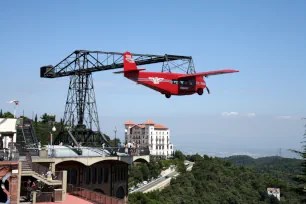
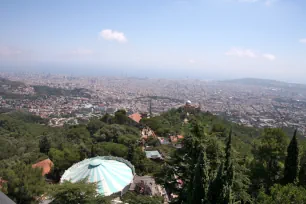
It started out small; the first main attraction was in fact the funicular that transported people to the top of the mountain, and the first large ride – an aerial railway – opened in 1911.
Today the amusement park occupies some 70,000 square meters with about twenty-five attractions ranging from an antique carousel to roller coasters. The attractions are laid out around six different levels on the top of the Tibidabo.
Many of the attractions still have a nostalgic feel, such as L’Avió, an airplane that has been flying in circles since 1928, a haunted house and a mini train that takes visitors around the park. A particularly interesting attraction is the Museu d’Autòmats, an automation museum with more than forty different fairground machines from the nineteenth and twentieth centuries. But there are also modern attractions such as a 4D cinema and a state-of-the-art roller coaster.
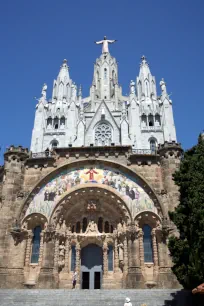
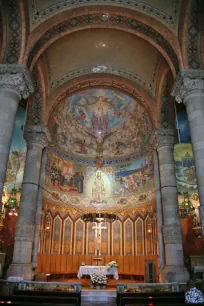
Temple of Tibidabo
Perched on top of the Tibidabo stands the Temple Expiatori del Sagrat Cor (Church of the Sacred Heart), Barcelona’s version of Paris’s Sacré-Coeur. Its silhouette is visible from all over Barcelona.
Construction of the church started in 1902 after an eclectic design by Enric Sagnier i Villavecchia. The church replaced an earlier chapel – the very first building on the Tibidabo – that was built here in 1886.
The crypt of the church, completed in 1909, is designed in Modernista style and decorated with colorful mosaics. Inside are sculptures created by Eusebio Arnau. Contrasting with the brown modernist base of the crypt is the church proper, a white Neo-Gothic structure with a colorful interior. Stairs on either side of the base lead to the balcony on top of the crypt, where you have a magnificent view over Barcelona. For an even higher vantage point, you can take an elevator to the top, where a winding staircase leads you just under the feet of the large statue of Christ.
Torre de Collserola
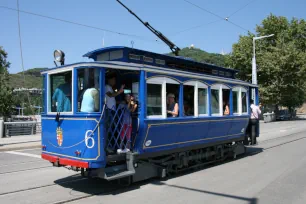
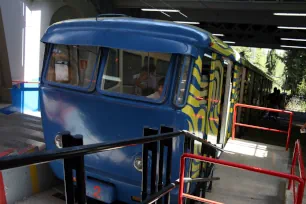
Getting There
Getting to Tibidabo may sound complicated, but the trip to the top of the mountain is half the fun.
Starting from the Plaça de Catalunya you take the underground train (L7) to Av. Tibidabo, the last stop. Across the street from this station, there is a tram stop, from where a historic tram – the Tramvia Blau (Blue Tram) – runs up the hill to the Plaça Doctor Andreu, the starting point of the Funicular railway that takes you to the top of the Tibidabo, right near the Parc d’Attractions and Temple of Tibidabo.
Both the tram and funicular – built by a Swiss company – opened in 1901, allowing people to get to the newly created fairground.
If this sounds too cumbersome, you can alternatively take the Tibibus T2A from Plaça de Catalunya which brings you straight to the top of the mountain.

